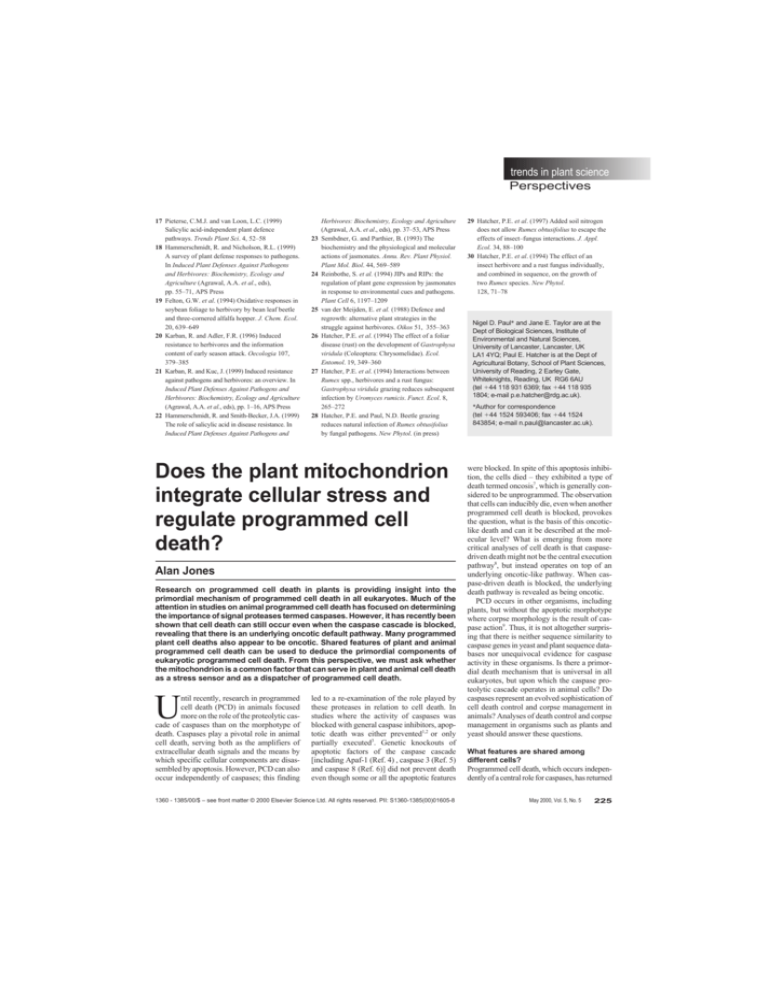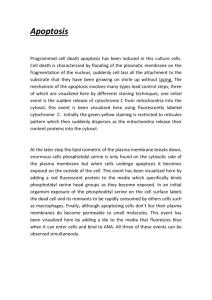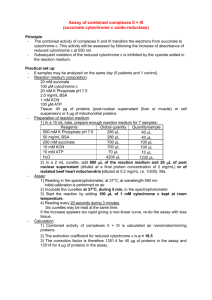
trends in plant science
Perspectives
17 Pieterse, C.M.J. and van Loon, L.C. (1999)
Salicylic acid-independent plant defence
pathways. Trends Plant Sci. 4, 52–58
18 Hammerschmidt, R. and Nicholson, R.L. (1999)
A survey of plant defense responses to pathogens.
In Induced Plant Defenses Against Pathogens
and Herbivores: Biochemistry, Ecology and
Agriculture (Agrawal, A.A. et al., eds),
pp. 55–71, APS Press
19 Felton, G.W. et al. (1994) Oxidative responses in
soybean foliage to herbivory by bean leaf beetle
and three-cornered alfalfa hopper. J. Chem. Ecol.
20, 639–649
20 Karban, R. and Adler, F.R. (1996) Induced
resistance to herbivores and the information
content of early season attack. Oecologia 107,
379–385
21 Karban, R. and Kuc, J. (1999) Induced resistance
against pathogens and herbivores: an overview. In
Induced Plant Defenses Against Pathogens and
Herbivores: Biochemistry, Ecology and Agriculture
(Agrawal, A.A. et al., eds), pp. 1–16, APS Press
22 Hammerschmidt, R. and Smith-Becker, J.A. (1999)
The role of salicylic acid in disease resistance. In
Induced Plant Defenses Against Pathogens and
23
24
25
26
27
28
Herbivores: Biochemistry, Ecology and Agriculture
(Agrawal, A.A. et al., eds), pp. 37–53, APS Press
Sembdner, G. and Parthier, B. (1993) The
biochemistry and the physiological and molecular
actions of jasmonates. Annu. Rev. Plant Physiol.
Plant Mol. Biol. 44, 569–589
Reinbothe, S. et al. (1994) JIPs and RIPs: the
regulation of plant gene expression by jasmonates
in response to environmental cues and pathogens.
Plant Cell 6, 1197–1209
van der Meijden, E. et al. (1988) Defence and
regrowth: alternative plant strategies in the
struggle against herbivores. Oikos 51, 355–363
Hatcher, P.E. et al. (1994) The effect of a foliar
disease (rust) on the development of Gastrophysa
viridula (Coleoptera: Chrysomelidae). Ecol.
Entomol. 19, 349–360
Hatcher, P.E. et al. (1994) Interactions between
Rumex spp., herbivores and a rust fungus:
Gastrophysa viridula grazing reduces subsequent
infection by Uromyces rumicis. Funct. Ecol. 8,
265–272
Hatcher, P.E. and Paul, N.D. Beetle grazing
reduces natural infection of Rumex obtusifolius
by fungal pathogens. New Phytol. (in press)
Does the plant mitochondrion
integrate cellular stress and
regulate programmed cell
death?
Alan Jones
Research on programmed cell death in plants is providing insight into the
primordial mechanism of programmed cell death in all eukaryotes. Much of the
attention in studies on animal programmed cell death has focused on determining
the importance of signal proteases termed caspases. However, it has recently been
shown that cell death can still occur even when the caspase cascade is blocked,
revealing that there is an underlying oncotic default pathway. Many programmed
plant cell deaths also appear to be oncotic. Shared features of plant and animal
programmed cell death can be used to deduce the primordial components of
eukaryotic programmed cell death. From this perspective, we must ask whether
the mitochondrion is a common factor that can serve in plant and animal cell death
as a stress sensor and as a dispatcher of programmed cell death.
U
ntil recently, research in programmed
cell death (PCD) in animals focused
more on the role of the proteolytic cascade of caspases than on the morphotype of
death. Caspases play a pivotal role in animal
cell death, serving both as the amplifiers of
extracellular death signals and the means by
which specific cellular components are disassembled by apoptosis. However, PCD can also
occur independently of caspases; this finding
led to a re-examination of the role played by
these proteases in relation to cell death. In
studies where the activity of caspases was
blocked with general caspase inhibitors, apoptotic death was either prevented1,2 or only
partially executed3. Genetic knockouts of
apoptotic factors of the caspase cascade
[including Apaf-1 (Ref. 4) , caspase 3 (Ref. 5)
and caspase 8 (Ref. 6)] did not prevent death
even though some or all the apoptotic features
1360 - 1385/00/$ – see front matter © 2000 Elsevier Science Ltd. All rights reserved. PII: S1360-1385(00)01605-8
29 Hatcher, P.E. et al. (1997) Added soil nitrogen
does not allow Rumex obtusifolius to escape the
effects of insect–fungus interactions. J. Appl.
Ecol. 34, 88–100
30 Hatcher, P.E. et al. (1994) The effect of an
insect herbivore and a rust fungus individually,
and combined in sequence, on the growth of
two Rumex species. New Phytol.
128, 71–78
Nigel D. Paul* and Jane E. Taylor are at the
Dept of Biological Sciences, Institute of
Environmental and Natural Sciences,
University of Lancaster, Lancaster, UK
LA1 4YQ; Paul E. Hatcher is at the Dept of
Agricultural Botany, School of Plant Sciences,
University of Reading, 2 Earley Gate,
Whiteknights, Reading, UK RG6 6AU
(tel 144 118 931 6369; fax 144 118 935
1804; e-mail p.e.hatcher@rdg.ac.uk).
*Author for correspondence
(tel 144 1524 593406; fax 144 1524
843854; e-mail n.paul@lancaster.ac.uk).
were blocked. In spite of this apoptosis inhibition, the cells died – they exhibited a type of
death termed oncosis7, which is generally considered to be unprogrammed. The observation
that cells can inducibly die, even when another
programmed cell death is blocked, provokes
the question, what is the basis of this oncoticlike death and can it be described at the molecular level? What is emerging from more
critical analyses of cell death is that caspasedriven death might not be the central execution
pathway8, but instead operates on top of an
underlying oncotic-like pathway. When caspase-driven death is blocked, the underlying
death pathway is revealed as being oncotic.
PCD occurs in other organisms, including
plants, but without the apoptotic morphotype
where corpse morphology is the result of caspase action9. Thus, it is not altogether surprising that there is neither sequence similarity to
caspase genes in yeast and plant sequence databases nor unequivocal evidence for caspase
activity in these organisms. Is there a primordial death mechanism that is universal in all
eukaryotes, but upon which the caspase proteolytic cascade operates in animal cells? Do
caspases represent an evolved sophistication of
cell death control and corpse management in
animals? Analyses of death control and corpse
management in organisms such as plants and
yeast should answer these questions.
What features are shared among
different cells?
Programmed cell death, which occurs independently of a central role for caspases, has returned
May 2000, Vol. 5, No. 5
225
trends in plant science
Perspectives
(a)
(b)
Oncosis
Vacuolar
Programmed
oncosis
Apoptotic
Lysosomal
Highly condensed
nucleus
Autophagic
Can oncosis be programmed in plants?
Apoptotic
body
Condensed
chromatin
Nucleus
ER
Trends in Plant Science
Fig. 1. Death morphotypes. (a) The morphology of the cell corpse depends on the way a cell
dies. Apoptotic, autophagic and lysosomal are three types of programmed cell death.
Apoptosis occurs in animal cells and has the hallmarks of nuclear condensation, cytoplasmic
blebbing and the involvement of a macrophage to remove the corpse. Autophagic degenerative
cell death involves autophagic organelles but often no nuclear condensation. Examples of this
type are found in both plant and animal cells. Lysosomal degenerative cell death involves the
loss of cytoplasm probably by the local secretion of hydrolases. Plant cells might use a form of
this type, discussed in (b). In contrast with a programmed cell death, oncosis is viewed as accidental death where metabolic homeostasis fails. Oncotic cells and organelles are swollen and
the plasma membrane is broken. One other possible outcome is for a cell to initiate apoptosis
but fail to complete it, in which case, death is manifested as oncotic. Programmed cell death is
manifested as autophagic and oncotic. Oncotic death is introduced here as ‘programmed oncosis’. (b) Many plant cells trigger death by disrupting the tonoplast in a program called vacuolar degenerative cell death. Hydrolases, sequestered in the vacuole until the moment of
triggering death, are synthesized de novo in response to signals that prepare the cell to die. The
sudden release of hydrolases results in a programmed oncosis morphotype.
our attention to the death morphotype: are the
different molecular mechanisms for programmed cell death in animals10 and plants11
manifested as different death morphotypes, or
are the death morphotypes points along a
continuum?
The morphology of dying animal cells has
been thoroughly documented12. The first
major distinction among dying cell morphotypes defines death as an active program,
whereby the cell is dismantled in an orchestrated and predictable manner compared with
the unprogrammed, unorganized management
of corpse removal (Fig. 1). Programmed cell
death in animals has been categorized into
three morphotypes:
Morphotype 1 (apoptosis), has three
hallmark features:
• DNA appears marginalized on the nuclear
envelope (pyknosis) and is fragmented to
nucleosomal-sized lengths.
226
May 2000, Vol. 5, No. 5
The proposed mechanism involves the secretion of hydrolases from lysosomes. The
mechanism has been debated in the past, but
was eventually neglected without directly testing its function. However, recent examples of
the mechanism of plant cell death might resurrect interest in this type of death mechanism:
PCD in plant cells often involves the conversion of the vacuole into a lytic compartment
that discharges its hydrolases when triggered.
In contrast with apoptosis, oncotic death,
which is induced by cellular insults (both
chemical and mechanical) is manifested by
swelling cytoplasm, mitochondria and other
organelles, and by the leakage of cellular
contents into the surroundings. Although the
presence of the cellulosic wall precludes cytoplasmic swelling, plant PCD shares many of
the animal oncosis features, such as disruption
of membranes and swelling of organelles16–19.
• The nucleus and cytoplasm are fragmented
into vesicles.
• Macrophages remove the corpse in vivo.
This type of PCD is the best understood and
is used to study animal PCD.
Morphotype 2 (autophagic or cytoplasmic
degenerative PCD), might or might not display
nuclear degradation and pyknosis, and usually
does not involve the participation of
macrophages, although its hallmark feature is
the consumption of cytoplasm by autophagic
organelles. This morphotype is often found
where death occurs en mass, such as in the
degeneration of the tadpole tail13, the intersegmental muscle of insect larvae10, and in chick
neurons14. It has also been documented in plant
cells, such as in the embryonic suspensor15.
Morphotype 3 (lysosomal degenerative
PCD) is the least understood. It is classified by
its general loss of cytoplasm without the clear
involvement of an organelle or another cell.
It is argued that apoptosis and oncosis in animal cells are at opposite ends of a continuum20. Apoptotic death is thought to involve
an active program whereas oncosis is viewed
as ‘accidental’ death and represents the cell’s
inability to either repair the damage or to initiate a death program that contains a corpseprocessing subroutine manifest as one of the
three morphotypes discussed21. Can death by
either apoptosis or oncosis share the same
early molecular mechanism? Can an oncotic
corpse morphotype result from a programmed
cell death in animals? From an evolutionary
viewpoint, it is difficult to imagine that animal
cells would initiate oncosis because the undesirable leakage of cellular content would probably lead to tissue inflammation. However,
this constraint does not apply to plant cells,
and in several plants the developmental and
pathogen-induced programmed cell death
processes appear oncotic.
Recent results (showing that PCD can
occur independently of caspase activity) indicate that underlying an apoptotic program is
another program complete with hydrolases
that manage the corpse up to the point of
phagocytosis. This could represent a primordial part of PCD, shared by both plants and
animals, which in animals evolved sophistications of the apoptotic program.
Understanding how ‘programmed oncosis’
might operate requires a quick review of the
role of the mitochondrion in PCD. When cellfree systems were developed to study PCD in
animals, several apoptosis-activating factors
(Apaf) were found22,23; one of these is
cytochrome c. Cytochrome c acts in the cytoplasm by recruiting caspases via an adapter
called Apaf1 (Ref. 24). In the current model,
cytochrome c and ATP cause Apaf1, an
adaptor protein that contains caspase recruitment domains, to dimerize thus bringing
trends in plant science
Perspectives
procaspase 9 (another Apaf) into close proximity to transactivate each other and to activate downstream caspases.
How cytochrome c gets to the cytoplasm is
a fascinating story that is still unfolding. It
seems that there are at least two mechanisms25
(Fig. 2):
(1) Via the formation of a transient pore
into the mitochondrial matrix. This
pore is called the permeability transition (PT) pore and is formed by the
transient complex of the voltagedependent anion channel (VDAC) on
the outer membrane, the adenine
nucleotide transporter (ANT) from the
inner membrane and cyclophilin D in
the matrix. The inner membrane is normally impermeable to anions, but when
the PT pore forms, it is thought that
the rapid movement of water causes
this compartment to swell, rupturing
the outer membrane to release
cytochrome c.
(2) Via the VDAC (Ref. 26); this is not
associated with mitochondrial swelling
and rupture. The route for calciuminduced release of cytochrome c can
differ depending on the tissue27. In rat
liver, the PT pore forms to release
cytochrome c, whereas in rat brain,
cytochrome c is released by a PT-independent means, probably directly via
the VDAC.
In most, if not in all cases examined, calcium
activates the release only at low ATP levels.
This point is important as there are several
cases where calcium induces cell death in
plants when ATP pools are reduced.
How universal is this death signaling
mechanism?
Under conditions where ATP pools are low,
calcium is the fundamental pore-activator in
all cells tested28. Oxidative stress also triggers
PT pore-opening directly29 and possibly also
indirectly by elevating calcium levels30.
Calcium-induced PT pore-opening can be
blocked by scavengers of reactive oxygen
species (ROS), therefore there appears to be
dependency between ROS and calcium in
pore opening31,32. Accordingly, inhibition of
electron transport, such as with nitric oxide33,
reduces ATP pools34, elevates ROS pools and,
under conditions of elevated calcium, activates the pore. The mitochondrion is thought
to integrate various stresses and, once triggered by a calcium increase, signals the cytoplasm to execute the PCD (Fig. 3).
Programmed oncosis might be the outcome
of unsuccessful apoptotic corpse management
in animal cells, but be a program in itself in
plant cells. In animal cells, the death program
is activated by cytochrome c release, but when
there is insufficient ATP to carry out the
(a)
Cytochrome c
ANT
VDAC
Ca2+
PT pore
(b)
(c)
Trends in Plant Science
Fig. 2. (a) Cytochrome c release into the cytosol occurs in at least two ways (b and c), both
require calcium flux at low cellular ATP levels. In the first (b), the permeability transition pore
(PT pore) forms as a complex with the voltage-dependent anion channel (VDAC), the adenine
nucleotide translocator (ANT), cyclophilin D (not shown) and the benzodiazepine receptor (not
shown). The PT pore permits water to move into the matrix; outer membrane rupturing occurs
when the inner membrane swells. (c) Cytochrome c can also be released directly via the VDAC.
Cytochrome c
Calcium flux
PT pore
Oxidative
stress
b5
∆Ψ
H2O
e–
IV
O2
III
e– e–
Fp5 NADH
O2–
I
O2
NADH
Electron transport stress
Trends in Plant Science
Fig. 3. Does the plant mitochondrion integrate stress signals for programmed cell death
(PCD)? There are many different situations that lead to cytochrome c release. These include
oxidative stresses that induce permeability transition (PT) pore formation, stresses on electron
transport and a rise in calcium levels. It is proposed that when cells are unable to maintain
metabolic homeostasis and the stresses overwhelm the cell, that mitochondria release
cytochrome c triggering death. These stresses are normal components of PCD in plant cells.
proteolytic caspase cascade, the result might
be oncosis-like death. Because this type of
death is active and triggered, it can be thought
of as programmed, but the morphotype is that
of oncosis (Fig. 1).
Cytochrome c release might also be important in plant cell death. Recently, it has been
shown that maize cells induced to die by the
addition of D-mannose release cytochrome c
to the cytosol35. Interestingly, D-mannose
inhibits hexokinase and reduces ATP levels36,
a prerequisite for calcium-induced PT pore
formation. A plausible explanation for mannose action is that it lowers ATP levels and
raises ROS levels to a point where the high
calcium levels found in the culture medium
May 2000, Vol. 5, No. 5
227
trends in plant science
Perspectives
trigger the PT pore and cytochrome c release.
Cytochrome c release also precedes heat-37
and menadione-induced38 death in plant cells.
Furthermore, the addition of cytochrome c to
carrot cytoplasmic extract induces apoptotic
features of added mouse nuclei39. Admittedly,
the evidence for cytochrome c release in plants
is barely sufficient, but the new data suggests
that plants and animals share the mitochondrial component of PCD, and therefore this
could represent the primordial component of
the program.
Without prototypical caspases in the plant
genome, one must wonder how cytochrome c
activates plant PCD. It has been proposed
that cytochrome c release generates lethal levels of ROS by blocking electron transport and
therefore this might have been the primordial
mechanism by which the endosymbiotic
mitochondrion killed its host40. Equally
plausible is the suggestion that caspase
function is fulfilled by other divergent proteases in plants.
Are mitochondria integrators of stress
and regulators of plant PCD?
It is clear that the mitochondrial PT pore complex is a sensor of cellular stress and that it
releases apoptogenic factors that trigger death
in animal cells. Is this the case in plant cells,
and how might the role of calcium perturbation
and ROS generation in plant PCD explain cell
death regulation? Research on the signal transduction pathway leading to HR has led to the
view that ROS is an inductive death signal53.
The primary role for nitric
oxide could be as an antibacterial agent – indirectly
stressing cells to the point
of triggering death by
permeability transition
pore formation
Are some plant cell deaths programmed
oncosis?
The typical hypersensitive response (HR)
morphotype induced by a pathogen is generally thought to be oncotic-like (except for
one report of an apoptotic morphotype41 associated with the HR); an example of a
morphotype induced by a bacterial pathogen
is described in Ref. 18 and an example of a
morphotype induced by a fungal pathogen is
described in Ref. 19. Dying cells leak, their
organelles swell, and the corpse is unprocessed
and left to be crushed by the surrounding
cells. Although this response to pathogenic
biotrophs might appear to be accidental death,
there is clear evidence that this type and
other death pathways are programmed. All
known PCD in plants requires a calcium
influx42–45, but calcium alone is insufficient
to trigger death, suggesting that calcium
influx serves only as the trigger in a cell
that becomes competent to die by PCD. HR
can be blocked pharmacologically and there
are mutants that mimic the HR in the absence
of a pathogen46, further indicating that this
oncotic-like death is programmed.
Cell death associated with the HR clearly
involves ROS [Ref. 47; including multiple
sources and types of ROS (Ref. 48)] and it is
generally thought that these are directed
against pathogens49. In generating ROS, the
cell places itself in a precarious position
between mounting a defense and eliciting
cytoplasmic oxidative stress. Indeed, the
evolution of defensive ROS is accompanied
by redox homeostatic mechanisms that presumably attenuate cytoplasmic oxidative
stress50,51. It has been shown that a failure to
control the cytoplasmic redox has dire consequences for the cell52.
228
May 2000, Vol. 5, No. 5
However, ROS might not be a signal but rather
a stress, one of many that are integrated by
mitochondria. This alternative conclusion is
more than mere semantics. Plant cells certainly mount defense responses against
pathogens that include an arsenal of ROS
(Ref. 19). For some responses, low levels of
ROS might be sufficient to keep pathogens at
bay whereas others require additional ROS
and additional tactical maneuvers. It is known
that plant cells have the means to attenuate
ROS stress cytoplasmically and do so at high
ROS levels during pathogen defense54. But is
there some level of ROS that overwhelms the
cell’s ROS homeostasis machinery and favors
the initiation of PCD? If so, the mitochondrion
is the ideal organelle to integrate the level of
stress and to coordinate PCD when warranted.
ROS are generated by mitochondria, chloroplasts and other organelles during their normal
activities, and at the same time are sensitive to
reactive oxygen stresses. One mechanism
for this is via the release of cytochrome c at
high levels of calcium, and the converse is
true: the release of cytochrome c leads to ROS
generation.
Much attention has been placed on the
possible role of nitric oxide (NO) in plant cell
death55, with the conclusion that NO is the
signal that triggers cell death in the HR.
However, plants might use NO as an antibacterial agent (it forms peroxynitrite after
reaction with oxygen) rather than a direct signal of cell death, making NO a stress rather
than a signal. Furthermore, NO can release
calcium by nitrosylation of the ryanodine
channel30 and therefore potentially can induce
PT pore formation. Direct NO effects on
mitochondria have also been noted, including
PT pore formation56. Finally, NO has been
shown to reduce ATP by the inhibition of
electron transport34, another requisite for PT
pore formation. Thus, it is conceivable that
the primary role for NO is as an anti-bacterial agent that might indirectly stress cells to
the point of triggering death by PT pore
formation.
Genetic screens to identify mimics of cell
death have been successful46. Some of these
genetic lesions might define genes in a signal
transduction pathway in PCD. However, it
remains possible that many lesions lead to
death by altering plant cell redox or inappropriately causing PT pore formation, such as
the les22 lesion mimic in maize57, which has
been cloned and found to encode uroporphyrinogen decarboxylase, an enzyme in the
porphyrin biosynthesis pathway. The les22
mutants have elevated uroporphyrin, a compound with a similar structure to protoporphyrin IX. Interestingly, protoporphyrin IX,
induces PT pore formation in animal cells58,
suggesting that a similar mechanism triggering death could occur in these plant cells.
Alternatively, because catalase and peroxidase are heme-containing enzymes they might
be less active in the les22 mutants and therefore more susceptible to internally generated
ROS (Ref. 57). In either case, the explanation
leads ultimately to PT pore formation as a possible cause of death.
Do plant cells regulate permeability
transition pore formation and
cytochrome c release with Bcl-like
proteins?
In animal cells, apoptotic and anti-apoptotic
proteins operate, at one level, by interacting
with mitochondria. Although it is not fully
understood how this occurs, anti-apoptotic
proteins, such as Bcl-2, might bind to the
VDAC and prevent cytochrome c release59,60.
Bcl-2 also has other downstream effects on
caspases61,62, but if its fundamental role is to
block cytochrome c release from mitochondria, it might block cell death even in
organisms lacking Bcl-2 homologs and
downstream caspases. Apoptotic proteins,
such as Bax, counter the action of Bcl-2,
probably by promoting cytochrome c release.
Recent evidence indicates that Bcl-2 and Bax
fulfill similar roles in plant cells and yeast.
Mitochondria-targeted Bax triggered cell
death when expressed via the tobacco mosaic
virus (TMV) in TMV resistant plants: leaves
developed lesions with a tissue and kinetic
pattern similar to the HR (Ref. 63).
Conversely, when the anti-apoptotic gene
Bcl-XL was expressed in tobacco, death
induced by UV, paraquat or TMV (known
inducers of cellular ROS) was suppressed64.
What do these results tell us about the role of
trends in plant science
Perspectives
BCL-like proteins (BLPs) in plant PCD? One
possible interpretation is that divergent
proteins might act in plants, suggesting
conservation of the pathway. However, an
alternative view is that only the PT pore complex is structurally conserved between plants
and animals. Thus, BLPs can operate in plant
cells, but they do not necessarily do so.
Even if plants lack prototypical caspases
and BLPs (as appears likely given the failure
to identify candidates in the public databases),
the activity of heterologous BLPs in plant
cells suggest a similar role for mitochondria
in both plant and animal PCD, namely, regulating a cell death program.
Is the molecular mechanism of corpse
processing plastic?
One clear difference between plant and animal
PCD is that animal PCD appears to be
instantly ready for activation and is a rapid
process. Consequently, animal cells have PCD
dampers and complex feedback controls. By
contrast, plant cells must first acquire the competency to trigger death and they process the
corpse cell autonomously, although the
processing differs between plant PCDs.
For example, during tracheary element
differentiation PCD results in complete autolysis of the cytoplasm, while leaving behind
the extracellular matrix. During lysigenous
aerynchyma formation, PCD results in the
complete removal of the corpse, whereas HRinduced PCD shows no evidence of corpse
removal. In each case, different internal and
external signals direct the cell on how to prepare for its death and how the corpse will be
processed. Several genes encoding hydrolases
that are up-regulated are common to all plant
PCDs, whereas some genes are unique to each
type of ‘preparation’ for death. Thus, differences in the profiles of these nascent hydrolases might account for the underlying
differences in corpse removal.
The plant cell is unique in that its central
large vacuole can sequester hydrolases. The
disruption of the tonoplast and the subsequent
release of the sequestered hydrolases appears
to be a common feature of plant PCD (Fig. 1).
Perhaps it is time to define a new type of PCD
based on the role of the vacuole, thus avoiding a term based on morphology, such as
‘programmed oncosis’.
Finally, we need to rethink the role of ROS
in controlling death. It is unlikely that these
molecules simply serve as cellular signals for
cell death, at least not by the traditional
definition of a signal. We need to test the
hypothesis that ROS, including NO, might act
as stress inducers at the level of the mitochondrion or the chloroplast. Oxidative stress,
not ROS, could be the cell death signal and the
target could be the mitochondrion as it is in
animal cells.
Acknowledgements
My thanks to Guido Kroemer and Yair M.
Heimer for their comments. Work on programmed cell death in my laboratory is supported by the National Science Foundation.
References
1 Chautan, M. et al. (1999) Interdigital cell
death can occur through a necrotic and caspaseindependent pathway. Curr. Biol. 9,
967–970
2 Vercammen, D. et al. (1998) Dual signaling of
the Fas receptor: initiation of both apoptotic and
necrotic cell death pathways. J. Exp Med. 188,
919–930
3 McCarthy, N.J. et al. (1997) Inhibition of
Ced3/ICE-related proteases does not prevent
cell death induced by oncogenes, DNA damage,
or Bcl-2 homologue Bak. J. Cell Biol. 136,
215–217
4 Yoshida, H. et al. (1998) Apaf1 is required for
mitochondrial pathways of apoptosis and brain
development. Cell 94, 739–750
5 Woo, M. et al. (1998) Essential contribution of
caspase 3/CPP32 to apoptosis and its associated
nuclear changes. Genes Dev. 12, 806–819
6 Kawahara, A. et al. (1998) Caspase-independent
cell killing by Fas-associated protein with death
domain. J. Cell Biol. 143, 1353–1360
7 Levin, S. et al. (1999) The nomenclature of
cell death: recommendations of an ad hoc
committee of the society of toxicologic
pathologists. Toxicol. Pathol. 27,
484–490
8 Green, D. and Kroemer, G. (1998) The central
executioners of apoptosis: caspases or
mitochondria? Trends Cell Biol. 8, 267–271
9 Groover, A.T. et al. (1997) Programmed cell
death of plant tracheary elements differentiating
in vitro. Protoplasma 196, 197–211
10 Schwartz, L.M. et al. (1993) Do all programmed
cell deaths occur via apoptosis? Proc. Natl. Acad.
Sci. U. S. A. 90, 980–984
11 Jones, A.M. and Dangl, J.D. (1996) Logjam
at the Styx: programmed cell death in plants.
Trends Plant Sci. 1, 114–119
12 Clarke, P.G.H. (1990) Developmental cell
death: morphological diversity and multiple
mechanisms. Anat. Embryol. 181, 195–213
13 Fox, H. (1973) Degeneration in the tail
notochord of Rana temporaria larvae at
metamorphic climax: examination by electron
microscopy. Z. Zellforsch. Mikrosk. Anat. 138,
371–386
14 Clarke, P.G.H. (1984) Identical populations of
phagocytes and dying neurons revealed by
intravascularly injected horseradish peroxidase,
and by endogenous glutaraldehyde-resistant
acid phosphatase, in the brains of chick embryos.
Histochem. J. 16, 9555–9569
15 Nagl, W. (1977) ‘Plastolysomes’ plastids
involved in the autolysis of the embryo
suspensor in Phaseolus. Z. Pflanzenphysiol.
85, 45–51
16 Groover, A.T. et al. (1997) Programmed cell
death of plant tracheary elements differentiating
in vitro. Protoplasma 196, 197–211
17 Campbell, R. and Drew, M.C. (1983) Electron
microscopy of gas space (aerenchyma) formation
in adventitious roots of Zea mays L. subjected to
oxygen shortage. Planta 157, 350–357
18 Bestwick, C.S. et al. (1997) Localization of
hydrogen peroxide accumulation during the
hypersensitive reaction of lettuce cells to
Pseudomonas syringae pv. phaseolicola. Plant
Cell 9, 209–221
19 Xu, H. and Mendgen, K. (1991) Early events in
living epidermal cells and broad bean during
infection with basidiospores of the cowpea rust
fungus. Can. J. Bot. 69, 2279–2285
20 Kroemer, G. et al. (1998) The mitochondrial
death/life regulator in apoptosis and necrosis.
Annu. Rev. Physiol. 60, 619–642
21 Leist, M. and Nicotera, P. (1997) The shape of cell
death. Biochem. Biophys. Res. Commun. 236, 1–9
22 Newmeyer, D.D. et al. (1994) Cell-free apoptosis
in Xenopus egg extracts: inhibition by Bcl-2 and
requirement for an organelle fraction enriched in
mitochondria. Cell 79, 353–364
23 Wilson, M.R. (1998) Apoptosis: unmasking the
executioner. Cell Death Differ. 5, 646–652
24 Zou, H. et al. (1999) An APAF-1·cytochrome c
multimeric complex is a functional apoptosome
that activates procaspase-9. J. Biol. Chem. 274,
11549–11556
25 Green, D.R. and Reed, J.C (1998)
Mitochondria and apoptosis. Science 281,
1309–1312
26 Shimizu, S. et al. (1999) Bcl-2 family proteins
regulate the release of apoptogenic cytochrome c
by the mitochondrial channel VDAC. Nature
399, 483–487
27 Andreyev, A. and Fiskum, G. (1999) Calcium
induced release of mitochondrial cytochrome c
by different mechanisms selective for brain
versus liver. Cell Death Differ. 6, 825–832
28 Crompton, M. (1999) The mitochondrial
permeability transition pore and its role in cell
death. Biochem. J. 341, 233–249
29 Petronilli, V. et al. (1994) The voltage sensor of
the mitochondrial permeability transition pore is
tuned by the oxidation–reduction state of vicinal
thiols. Increase of the gating potential by oxidants
and its reversal by reducing agents. J. Biol.
Chem. 269, 16638–16642
30 Xu, L. et al. (1998) Activation of the cardiac
calcium release channel (ryanodine receptor) by
poly-S-nitrosylation. Science 279, 234–237
31 Scorrano, L. et al. (1997) On the voltage
dependence of the mitochondrial permeability
transition pore. A critical appraisal. J. Biol.
Chem. 272, 12295–12299
32 Kowaltowski, A.J. et al. (1996) Effect of
inorganic phosphate concentrations on the
nature of inner mitochondrial alterations
mediated by Ca21 ions. A proposed model for
phosphate-stimulated lipid peroxidation. J. Biol.
Chem. 271, 2929–2934
May 2000, Vol. 5, No. 5
229
trends in plant science
Perspectives
33 Bosca, L. and Hortelano, S. (1999) Mechanisms
of nitric oxide-dependent apoptosis: involvement
of mitochondrial mediators. Cell. Signal. 11,
239–244
34 Brown, G.C. (1999) Nitric oxide and
mitochondrial respiration. Biochim. Biophys. Acta
1411, 351–369
35 Stein, J.C. and Hansen, G. (1999) Mannose
induces an endonuclease responsible for DNA
laddering in plant cells. Plant Physiol. 121,
71–79
36 Goldsworthy, A. and Street, H.E. (1965) The
carbohydrate nutrition of tomato roots. VIII.:
the mechanism of the inhibition by D-mannose
of the respiration of excised roots. Ann. Bot. 29,
45–58
37 Balk, J. et al. (1999) Translocation of
cytochrome c from the mitochondria to the
cytosol occurs during heat-induced programmed
cell death in cucumber plants. FEBS Lett. 463,
151–154
38 Sun, Y-L. et al. (1999) Cytochrome c release
and caspase activation during menadioneinduced apoptosis in plants. FEBS Lett. 462,
317–321
39 Zhao, Y. et al. (1999) Apoptosis of mouse liver
nuclei induced in the cytosol of carrot cells.
FEBS Lett. 448, 197–200
40 Blackstone, N.W. and Green, D.R. (1999) The
evolution of a mechanism of cell suicide.
BioEssays 21, 84–88
41 Levine, A. et al. (1996) Calcium-mediated
apoptosis in a plant hypersensitive disease
resistance response. Curr. Biol. 6, 427–437
42 He, C-J. et al. (1996) Transduction of an ethylene
signal is required for cell death and lysis in the
root cortex of maize during aerenchyma
formation induced by hypoxia. Plant Physiol.
112, 463–472
43 Navarre, D. and Wolpert, T.J. (1999) Victorin
induction of an apoptotic/senescence-like
response in oats. Plant Cell 11, 237–250
44 Groover, A. and Jones, A.M. (1999)
Programmed cell death in transdifferentiating
tracheary elements is triggered by a secreted
protease. Plant Physiol. 119, 375–384
45 Xu, H. and Heath, M.C. (1998) Role of calcium
in signal transduction during the hypersensitive
response caused by basidiospore-derived
infection of the cowpea rust fungus. Plant Cell
10, 585–597
46 Buckner, B. et al. (1998) Cell-death
mechanisms in maize. Trends Plant Sci. 3,
218–223
47 May, M.J. et al. (1996) Involvement of reactive
oxygen species, glutathione metabolism, and lipid
peroxidation in the Cf-dependent defense
response of tomato cotyledons induced by racespecific elicitors of Cladosporium fulvum. Plant
Physiol. 110, 1367–1379
48 Allan, A.C. and Fluhr, R. (1997) Two distinct
sources of elicited reactive oxygen species in
tobacco epidermal cells. Plant Cell 9,
1559–1572
49 Mehdy, M.C. (1994) Active oxygen species in
plant defense against pathogens. Plant Physiol.
105, 467–472
50 May, M.J. et al. (1998) Glutathione homeostasis
in plants: implications for environmental sensing
and plant development. J. Exp. Biol. 49,
649–667
51 Alscher, R.G. et al. (1997) Reactive oxidants and
antioxidants: relationship in green cells. Physiol.
Plant. 100, 224–233
52 Jabs, T. et al. (1996) Initiation of runaway cell
death in an Arabidopsis mutant by extracellular
superoxide. Science 273, 1853–1856
53 Levine, A. et al. (1994) H2O2 from the oxidative
burst orchestrates the plant hypersensitive
disease resistance response. Cell 79, 583–593
54 Noctor, G. and Foyer, C.H. (1998) Ascorbate and
glutathione: keeping active oxygen under control.
Annu. Rev. Plant Physiol. Plant Mol. Biol. 49,
249–279
55 Bolwell, G.P. (1999) Role of active oxygen
species and NO in plant defence responses.
Curr. Opin. Plant Biol. 2, 287–294
56 Bernardi, P. (1996) The permeability transition
pore. Control points of a cyclosporin A-sensitive
mitochondrial channel involved in cell death.
Biochim. Biophys. Acta 1275, 5–9
57 Hu, G. et al. (1998) A porphyrin pathway
impairment is responsible for the phenotype of a
dominant disease lesion mimic mutant of maize.
Plant Cell 10, 1095–1105
58 Marchetti, P. et al. (1996) Mitochondrial
permeability transition triggers lymphocyte
apoptosis. J. Immunol. 157, 4830–4836
59 Kluck, R.M. et al. (1997) The release of
cytochrome c from mitochondria: a primary site
for Bcl-2 regulation of apoptosis. Science 275,
1132–1136
60 Yang, J. et al. (1997) Prevention of apoptosis
by Bcl-2: release of cytochrome c from
mitochondria blocked. Science 27,
1129–1132
61 Zhivotovsky, B. et al. (1998) Injected
cytochrome c induces apoptosis. Nature 391,
449–450
62 Rosse, T. et al. (1998) Bcl-2 prolongs cell
survival after Bax-induced release of
cytochrome c. Nature 391, 496–499
63 Lacomme, C. and Santa Cruz, S. (1999)
Bax-induced cell death in tobacco is similar to
the hypersensitive response. Proc. Natl. Acad.
Sci. U. S. A. 96, 7956–7961
64 Mitsuhara, I. et al. (1999) Animal cell-death
suppressors Bcl-XL and Ced-9 inhibit cell death in
plants. Curr. Biol. 9, 775–778
Alan R. Jones is at the Dept of Biology, The
University of North Carolina at Chapel Hill,
Chapel Hill, NC 27599-3280, USA
(e-mail alan_jones@unc.edu).
Trends in Plant Science Perspectives
Perspectives articles are your opportunity to express personal views on topics of interest to plant scientists. The range
of appropriate subject matter covers the breadth of plant biology: historical, philosophical or political aspects; potential
links between hitherto disparate fields; or simply a new view on a subject of current importance. Specific issues might
include: the allocation of funding; commercial exploitation of data; the gene sequencing projects; genetic engineering;
the impact of the Internet; education issues; or public perception of science. Current developments in other disciplines
may also be relevant.
Although Perspective articles are more opinionated in tone, they remain subject to stringent peer-review to ensure clarity
and accuracy. The decision to publish rests with the Editor. If you wish to write for the Perspectives section, please
contact the Editor before embarking on your manuscript, with a 200-word proposal and a list of key recent references
(plants@current-trends.com).
230
May 2000, Vol. 5, No. 5










